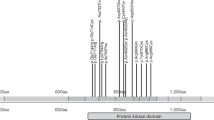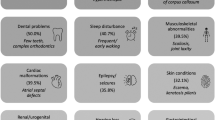Abstract
Communication difficulties are a core feature of Phelan-McDermid syndrome (PMS). However, a specific speech and language phenotype has not been delineated, preventing prognostic counselling and development of targeted therapies. We examined speech, language, social and functional communication abilities in 21 individuals with PMS (with SHANK3 involvement), using standardised assessments. Mean age was 9.7 years (SD 4.1) and 57% were female. Deletion size ranged from 41 kb to 8.3 Mb. Nine participants (45%) were non-verbal. Four (19%) had greater verbal ability, speaking in at least 4–5 word sentences, but with speech sound errors. Standard scores for receptive and expressive language were low (typically >3 SD below the mean). Language age equivalency was 13–16 months on average (range 2–53 months). There was a significant association between deletion size and the ability to use phrases. Participants with smaller deletion sizes were more likely to be able to use phrases (odds ratio: 0.36, 95% CI: 0.14–0.95, p = 0.040). Adaptive behaviour (life skills) was low in all areas (>2 SD below mean). Scores in communication were markedly lower than for daily living (p = 0.008) and socialisation (p < 0.001). A common linguistic profile was characterised by severe impairment across receptive, expressive and social language domains. Yet data indicated greater communicative intent than appeared to be capitalised by current therapies. Early implementation of augmentative (e.g. computer-assisted) modes of communication, alongside promotion of oral language, is essential to harness this intent, accelerate language development and reduce frustration. Future trials should examine the added benefit of targeted speech motor interventions in those with greater verbal capacity.
This is a preview of subscription content, access via your institution
Access options
Subscribe to this journal
Receive 12 print issues and online access
$259.00 per year
only $21.58 per issue
Buy this article
- Purchase on SpringerLink
- Instant access to full article PDF
Prices may be subject to local taxes which are calculated during checkout




Similar content being viewed by others
Change history
15 March 2021
A Correction to this paper has been published: https://doi.org/10.1038/s41431-021-00855-4
References
Phelan K, McDermid HE. The 22q13.3 deletion syndrome (Phelan-McDermid syndrome). Mol Syndromol. 2011;2:186–201.
Phelan MC. Deletion 22q13.3 syndrome. Orphanet J Rare Dis. 2008;3:14.
Durand CM, Betancur C, Boeckers TM, Bockmann J, Chaste P, Fauchereau F, et al. Mutations in the gene encoding the synaptic scaffolding protein SHANK3 are associated with autism spectrum disorders. Nat Genet. 2007;39:25–7.
Boeckers TM, Bockmann J, Kreutz MR, Gundelfinger ED. ProSAP/Shank proteins – a family of higher order organizing molecules of the postsynaptic density with an emerging role in human neurological disease. J Neurochem. 2002;81:903–10.
Kolevzon A, Angarita B, Bush L, Wang AT, Frank Y, Yang A, et al. Phelan-McDermid syndrome: a review of the literature and practice parameters for medical assessment and monitoring. J Neurodev Disord. 2014;6:39.
Tabet A-C, Rolland T, Ducloy M, Lévy J, Buratti J, Mathieu A, et al. A framework to identify modifier genes in patients with Phelan-McDermid syndrome. NPJ Genom Med. 2017;2:32. https://doi.org/10.1038/s41525-017-0035-2.
Soorya L, Kolevzon A, Zweifach J, Lim T, Dobry Y, Schwartz L. et al. Prospective investigation of autism and genotype-phenotype correlations in 22q13 deletion syndrome and SHANK3 deficiency. Mol Autism. 2013;4:18.
Zwanenburg RJ, Ruiter SAJ, van den Heuvel ER, Flapper BCT, Van Ravenswaaij-Arts CMA. Developmental phenotype in Phelan-McDermid (22q13.3 deletion) syndrome: a systematic and prospective study in 34 children. J Neurodev Disord. 2016;8:16.
De Rubeis S, Siper PM, Durkin A, Weissman J, Muratet F, Halpern D. et al. Delineation of the genetic and clinical spectrum of Phelan-McDermid syndrome caused by SHANK3 point mutations. Mol Autism. 2018;9:31.
Manning MA, Cassidy SB, Clericuzio C, Cherry AM, Schwartz S, Hudgins L, et al. Terminal 22q deletion syndrome: a newly recognized cause of speech and language disability in the autism spectrum. Pediatrics 2004;114:451–7.
Ponson L, Gomot M, Blanc R, Barthelemy C, Roux S, Munnich A. et al. 22q13 deletion syndrome: communication disorder or autism? Evidence from a specific clinical and neurophysiological phenotype. Translational Psychiatry. 2018;8:146.
Jeffries AR, Curran S, Elmslie F, Sharma A, Wenger S, Hummel M, et al. Molecular and phenotypic characterization of ring chromosome 22. Am J Med Genet Part A. 2005;137A:139–47.
Koolen DA, Reardon W, Rosser EM, Lacombe D, Hurst JA, Law CJ, et al. Molecular characterisation of patients with subtelomeric 22q abnormalities using chromosome specific array-based comparative genomic hybridisation. Eur J Hum Genet. 2005;13:1019–24.
Reierson G, Bernstein J, Froehlich-Santino W, Urban A, Purmann C, Berquist S, et al. Characterizing regression in Phelan McDermid Syndrome (22q13 deletion syndrome). J Psychiatr Res. 2017;91:139–44.
Oberman LM, Boccuto L, Cascio L, Sarasua S, Kaufmann WE. Autism spectrum disorder in Phelan-McDermid syndrome: initial characterization and genotype-phenotype correlations. Orphanet J Rare Dis. 2015;10:105.
Sarasua SM, Dwivedi A, Boccuto L, Chen C-F, Sharp JL, Rollins JD, et al. 22q13.2q13.32 genomic regions associated with severity of speech delay, developmental delay, and physical features in Phelan-McDermid syndrome. Genet Med. 2014;16:318.
Mei C, Fedorenko E, Amor DJ, Boys A, Hoeflin C, Carew P, et al. Deep phenotyping of speech and language skills in individuals with 16p11.2 deletion. Eur J Hum Genet. 2018;26:676–86.
Morgan AT, Haaften LV, van Hulst K, Edley C, Mei C, Tan TY, et al. Early speech development in Koolen de Vries syndrome limited by oral praxis and hypotonia. Eur J Hum Genet. 2018;26:75–84.
Dykens EM. Measuring behavioral phenotypes: provocations from the “new genetics”. Am J Ment Retard. 1995;99:522–32.
St John M, Ponchard C, van Reyk O, Mei C, Pigdon L, Amor DJ, et al. Speech and language in children with Klinefelter syndrome. J Commun Disord. 2019;78:84–96.
Brignell A, St John M, Boys A, Bruce A, Dinale C, Pigdon L, et al. Characterization of speech and language phenotype in children with NRXN1 deletions. Am J Med Genet Part B. 2018;177:700–8.
Rutter M, Le Couteur A, Lord C. Autism diagnostic interview-revised. Los Angeles, CA: Western Psychological Services; 2003.
StataCorp L. Stata statistical software: release 15. College Station, TX: StataCorp LP; 2017.
Ziats CA, Jain L, McLarney B, Vandenboom E, DuPont BR, Rogers C, et al. Neurofibromatosis type 2 in Phelan-McDermid syndrome: institutional experience and review of the literature. Eur J Med Genet. 2020;63:104042.
Webster KT, Raymond GV. 22q13 Deletion syndrome: a report of the language function in two cases. J Med Speech-Lang Pathol. 2004;12:41–6.
Nesslinger NJ, Gorski JL, Kurczynski TW, Shapira SK, Siegel-Bartelt J, Dumanski JP, et al. Clinical, cytogenetic, and molecular characterization of seven patients with deletions of chromosome 22q13.3. Am J Hum Genet. 1994;54:464–72.
Sarasua SM, Dwivedi A, Boccuto L, Rollins JD, Chen C-F, Rogers RC, et al. Association between deletion size and important phenotypes expands the genomic region of interest in Phelan–McDermid syndrome (22q13 deletion syndrome). J Med Genet. 2011;48:761–6.
Liao S-F, Liu J-C, Hsu C-L, Chang M-Y, Chang T-M, Cheng H. Cognitive development in children with language impairment, and correlation between language and intelligence development in kindergarten children with developmental delay. J Child Neurol. 2014;30:42–7.
Norrelgen F, Fernell E, Eriksson M, Hedvall A, Persson C, Sjolin M, et al. Children with autism spectrum disorders who do not develop phrase speech in the preschool years. Autism. 2015;19:934–43.
Levy SE, Giarelli E, Lee L-C, Schieve LA, Kirby RS, Cunniff C, et al. Autism spectrum disorder and co-occurring developmental, psychiatric, and medical conditions among children in multiple populations of the United States. J Dev Behav Pediatr. 2010;31:267–75.
Moss J, Howlin P, Oliver C. The assessment and presentation of autism spectrum disorder and associated characteristics in individuals with severe intellectual disability and genetic syndromes. The Oxford handbook of intellectual disability and development. New York: Oxford University Press; 2011. p. 275–302.
Moss J, Howlin P. Autism spectrum disorders in genetic syndromes: implications for diagnosis, intervention and understanding the wider autism spectrum disorder population. J Intellect Disabil Res. 2009;53:852–73.
Rutter M, Bailey A, Lord C. The social communication questionnaire. Los Angeles, CA: Western Psychological Services; 2003.
Morgan AT, Masterton R, Pigdon L, Connelly A, Liegeois FJ. Functional magnetic resonance imaging of chronic dysarthric speech after childhood brain injury: reliance on a left-hemisphere compensatory network. Brain. 2013;136:646–57.
Morgan AT, Su M, Reilly S, Conti-Ramsden G, Connelly A, Liégeois FJ. A brain marker for developmental speech disorders. J Pediatr. 2018;198:234–9.e1.
Liégeois F, Tournier J-D, Pigdon L, Connelly A, Morgan AT. Corticobulbar tract changes as predictors of dysarthria in childhood brain injury. Neurology. 2013;80:926–32.
Liégeois FJ, Turner SJ, Mayes A, Bonthrone AF, Boys A, Smith L, et al. Dorsal language stream anomalies in an inherited speech disorder. Brain. 2019;142:966–77.
Kasari C, Kaiser A, Goods K, Nietfeld J, Mathy P, Landa R, et al. Communication interventions for minimally verbal children with autism: a sequential multiple assignment randomized trial. J Am Acad Child Adolesc Psychiatr. 2014;53:635–46.
Sparrow SS, Cicchetti DV, Balla DA. Vineland adaptive behavior scales. 2nd ed. Minneapolis, MN: American Guidance Service; 2005.
Zimmerman IL, Steinger VG, Pond RE. Preschool language scales. 5th ed. San Antonio, TX: Psychological Corporation; 2011.
Dunn LM, Dunn DM. Peabody picture vocabulary test. 4th ed. Bloomington, MN: Pearson; 2007.
Wetherby AM, Prizant BM. Communication and symbolic behavior scales developmental profile. Baltimore, MD: Paul H. Brookes; 2002.
Mei C, Reilly S, Reddihough D, Mensah F, Pennington L, Morgan A. Language outcomes of children with cerebral palsy aged 5 years and 6 years: A population‐based study. Dev Med Child Neurol. 2016;58:605–11.
Dodd B, Zhu H, Crosbie S, Holm A, Ozanne A. Diagnostic evaluation of articulation and phonology. London, England: Psychological Corporation; 2002.
Robbins J, Klee T. Clinical assessment of oropharyngeal motor development in young children. J Speech Hearing Disord. 1987;52:271–7.
Sigafoos J, Woodyatt G, Keen D, Tait K, Tucker M, Roberts-Pennell D, et al. Identifying potential communicative acts in children with developmental and physical disabilities. Commun Disord Q. 2000;21:77–86.
Acknowledgements
We thank the individuals with PMS and their families for their participation. We also thank Megan Toole for her assistance with recruitment through the Phelan McDermid Syndrome Foundation of Australia.
Funding
Funding was provided by National Health and Medical Research Council (NHMRC) Practitioner Fellowship #1105008 (A.M.); NHMRC Centre of Research Excellence in Speech and Language Neurobiology #1116976 awarded to A.M., D.A.
Author information
Authors and Affiliations
Corresponding author
Ethics declarations
Conflict of interest
The authors declare that they have no conflict of interest.
Additional information
Publisher’s note Springer Nature remains neutral with regard to jurisdictional claims in published maps and institutional affiliations.
The original online version of this article was revised due to a typo
Supplementary information
Rights and permissions
About this article
Cite this article
Brignell, A., Gu, C., Holm, A. et al. Speech and language phenotype in Phelan-McDermid (22q13.3) syndrome. Eur J Hum Genet 29, 564–574 (2021). https://doi.org/10.1038/s41431-020-00761-1
Received:
Accepted:
Published:
Issue date:
DOI: https://doi.org/10.1038/s41431-020-00761-1
This article is cited by
-
Identification of a cryptic unbalanced translocation Der(22)t(12;22)(q24.33;q13.33) in a large Chinese family with Phelan-McDermid syndrome by nanopore sequencing
Scientific Reports (2025)
-
Genetic architecture of childhood speech disorder: a review
Molecular Psychiatry (2024)
-
Characterization of speech and language phenotype in the 8p23.1 syndrome
European Child & Adolescent Psychiatry (2024)
-
Sensory processing and adaptive behavior in Phelan-McDermid syndrome: a cross-sectional study
European Journal of Pediatrics (2022)
-
What’s new in EJHG in April
European Journal of Human Genetics (2021)



